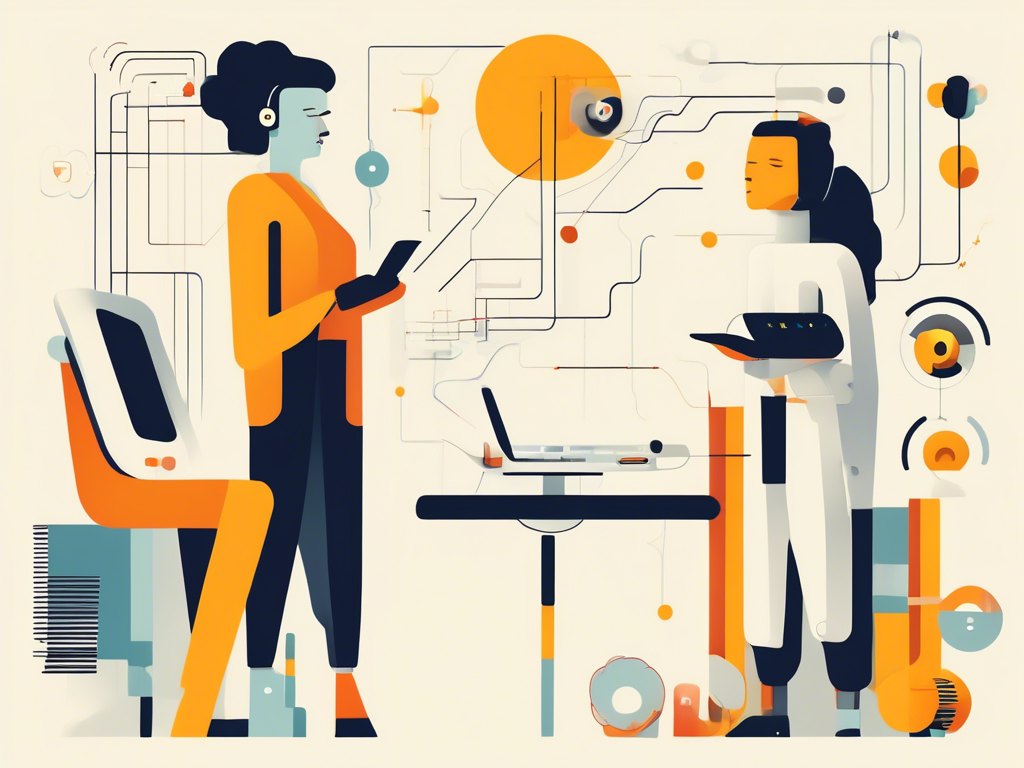The dawn of Artificial Intelligence (AI) has ushered in an unprecedented era of innovation, particularly within the realm of User Interface (UI) development. Once confined to the imaginations of sci-fi enthusiasts, AI is now a pivotal force in shaping how we interact with technology. In this article, we embark on a journey to explore the transformative impact of AI on modern UI design, delving into how it’s revolutionizing user experience with smart interfaces, and the instrumental role of machine learning in creating intuitive UI elements. We will also dissect the latest innovations in AI-driven UI patterns and best practices, before casting our gaze forward to evaluate the future of interface development through the lens of burgeoning AI technologies. The age of intelligent interfaces has arrived, and with it, a plethora of possibilities that will redefine human-computer interaction.
AI in User Interface Development

Enhancing User Experience with AI
The integration of Artificial Intelligence (AI) into User Interface (UI) design is revolutionizing the way users interact with digital products. AI technologies, such as machine learning and natural language processing, enable the development of interfaces that are more intuitive and responsive to user needs. By analyzing vast amounts of data on user behavior, AI can help identify patterns and predict user actions, allowing for the creation of personalized experiences. For instance, predictive text input and smart recommendations improve the efficiency and satisfaction of the user experience (UX), making digital interactions feel seamless and tailored to individual preferences. This personalization aspect not only enhances user engagement but also significantly boosts the usability of digital products.
Automating Design Processes
Another significant impact of AI on modern UI design is the automation of design tasks that traditionally required human intervention. Tools powered by AI can now generate design elements, suggest layouts, and even create color schemes based on best practices and current trends. This not only speeds up the design process but also opens up new possibilities for creativity and innovation. For designers, the use of AI can reduce the time spent on repetitive tasks, allowing them to focus more on the strategic aspects of design, such as understanding user needs and crafting unique user journeys. Moreover, AI-driven analytics tools offer insights into how users interact with a UI, providing valuable feedback that can be used to refine and improve designs. The ability to quickly iterate and test different designs based on real user data is a game changer in UI development, ensuring products are not only beautiful but also highly functional and user-centric.
By leveraging the power of AI, the field of UI design is undergoing a significant transformation. The focus is increasingly on creating experiences that are not just visually appealing but also intelligent and adaptive to user needs. As AI technology continues to evolve, its role in UI design will undoubtedly grow, opening new avenues for innovation and enhancing the way we interact with digital environments.
AI in User Interface Development
Revolutionizing User Experience Through Smart Interfaces
The advent of Artificial Intelligence (AI) in the realm of User Interface (UI) development is setting a new benchmark for user experiences. Smart Interfaces, powered by AI, are not just a futuristic concept but a present-day reality revolutionizing how users interact with digital platforms. These interfaces, equipped with machine learning, natural language processing, and predictive analytics, are transforming passive interfaces into dynamic, interactive environments. They can understand user preferences, anticipate needs, and even adapt in real-time, offering a level of personalization and accessibility previously unattainable.
For example, voice-activated assistants and chatbots have become more adept at understanding and processing natural language, enabling them to provide responses and services that are highly relevant and personalized. Similarly, smart recommendation systems in e-commerce platforms use AI to analyze browsing history, purchase patterns, and even social media behavior to suggest products that users are more likely to buy. This smart interface capability significantly enhances the user experience by making digital platforms more intuitive, efficient, and engaging.
Seamless Integration and Accessibility
One of the most significant impacts of AI on smart interfaces is their ability to create a seamless integration of technologies, thereby enhancing accessibility. AI-driven interfaces can adapt to the user’s preferred mode of interaction, whether it’s through text, voice, gestures, or even facial expressions. This flexibility not only improves user engagement but also ensures that digital products are accessible to a wider audience, including those with disabilities. For instance, visually impaired users can benefit from AI-powered applications that convert text to speech or interpret voice commands, making navigation easier and more intuitive.
Moreover, the incorporation of AI into UI development has led to the creation of interfaces that can learn and evolve based on user feedback and interactions. This continuous learning process ensures that the interface grows smarter over time, further improving accessibility and user satisfaction. By prioritizing the user’s convenience and creating an inclusive digital environment, AI is not just changing the interface we interact with but also redefining the standards of user experience and accessibility in the digital age.
Through the evolution of smart interfaces, AI in UI development is not only enhancing the aesthetics and functionality of digital products but is also profoundly impacting how we perceive and interact with technology. As AI continues to advance, its integration into user interfaces promises to unlock even more possibilities for innovation, personalization, and accessibility, truly revolutionizing the user experience.
The Role of Machine Learning in Crafting Intuitive UI Elements

Personalizing User Experiences with Predictive Analysis
Machine Learning (ML), a critical component of Artificial Intelligence (AI), plays a pivotal role in elevating the user interface (UI) to new heights of personalization. By harnessing the power of predictive analysis, ML algorithms analyze vast datasets of user interactions to identify patterns and preferences. This data-driven approach allows for the creation of UI elements that are not only intuitive but also tailored to the individual needs and behaviors of users. For example, streaming services leverage ML to curate personalized content recommendations, significantly enhancing user engagement and satisfaction. This level of personalization ensures that users encounter a UI that feels uniquely tuned to their interests, leading to a more engaging and satisfying digital experience.
By utilizing predictive analysis, developers can design UI elements that anticipate the user’s next move, offering suggestions or actions that streamline the user journey. This proactive approach to UI design, powered by machine learning, transforms the way users interact with digital platforms, making every interaction more efficient and personalized. The adoption of ML in crafting these intuitive UI elements signifies a shift towards more intelligent, user-centered design strategies that prioritize the unique preferences and needs of each user.
Enhancing Interface Accessibility Through Machine Learning
Beyond personalization, machine learning is instrumental in enhancing the accessibility of user interfaces. By learning from diverse user interactions, ML algorithms can adapt UI elements to accommodate various accessibility needs, making technology more inclusive. For instance, ML can optimize text size, contrast, and layout dynamically for users with visual impairments, or modify the user interface for those with motor difficulties, ensuring that digital products are accessible to everyone. This adaptive capability of machine learning underscores its potential to create UIs that are not just smart, but also empathetic to the full spectrum of human diversity.
Furthermore, machine learning enables voice-controlled interfaces and gesture recognition technologies to become more accurate and responsive, offering alternative methods of interaction that can significantly benefit users with disabilities. As these AI-driven interfaces evolve, the role of machine learning in eliminating barriers and enhancing usability for all users becomes increasingly apparent. This commitment to inclusivity through adaptive UI design showcases the transformative impact of machine learning on creating user interfaces that cater to the needs of a diverse user base.
The integration of machine learning into the development of intuitive UI elements represents a major leap forward in crafting digital experiences that are both personalized and inclusive. As AI technology continues to evolve, the potential for machine learning to further revolutionize UI design and accessibility is boundless, promising a future where digital interfaces can intuitively adapt to and meet the unique needs of every user.
Innovations in AI-driven User Interface Patterns and Best Practices
Adopting Conversational Interfaces for Enhanced Interaction
The adoption of conversational interfaces, powered by advancements in AI technology, is redefining user interactions in digital platforms. Unlike traditional graphical user interfaces (GUIs), conversational interfaces utilize natural language processing (NLP) to facilitate a more natural and intuitive form of interaction between the user and the system. This innovation allows users to communicate with digital products and services through text or voice-based commands, making the experience more engaging and accessible. By implementing conversational interfaces, developers can create user experiences (UX) that are not only efficient but also closely mimic human-to-human conversation, offering a level of personalization and convenience previously unachievable.
Additionally, these interfaces can process and understand user intent, even in complex dialogues, enabling them to provide responses and actions that are highly relevant and tailored to individual needs. For instance, AI-driven chatbots and virtual assistants have become increasingly sophisticated, capable of handling a wide range of tasks from customer service inquiries to personal shopping assistance, all through conversational interaction. This shift towards conversational UI is a testament to the continuous evolution in AI-driven interface design, emphasizing the importance of creating seamless, user-friendly interactions.
Leveraging Predictive UI for Anticipatory Design
Predictive UI represents another significant innovation in AI-driven user interface development, showcasing the potential of anticipatory design. By analyzing user behavior, preferences, and past interactions, AI algorithms can predict future actions and streamline the user experience by pre-loading information, suggesting relevant actions, or automating routine tasks. This predictive capability not only enhances the efficiency of digital interactions but also significantly improves user satisfaction by minimizing effort and time spent on predictable tasks.
For example, predictive text inputs that suggest the next word or phrase as the user types are now a common feature in many applications, saving time and reducing errors. Similarly, predictive analytics can be used to customize UI elements in real-time, adapting the interface to suit the context of use or the specific needs of the user. This approach to UI design, where the system anticipates the user’s next move and prepares the interface accordingly, is a powerful example of how AI is being used to create more intuitive and responsive digital environments. Through predictive UI, designers and developers can craft experiences that not only react to user inputs but also anticipate user needs, setting a new standard for intelligent, user-centric design.
Evaluating the Future of Interface Development with AI Technologies

Advancing Towards More Human-like Interactions
As we delve deeper into the future of interface development influenced by AI technologies, a prominent trend emerges towards achieving interfaces that mimic human-like interactions more closely. The evolution of AI-driven design is paving the way for interfaces that understand and interpret the nuances of human communication more effectively, breaking down the barriers between digital and human interaction. This progression is primarily driven by advancements in natural language processing (NLP) and emotion recognition technologies, enabling interfaces to respond not just to the explicit content of user inputs but also to the implied tones, emotions, and contexts.
As interfaces become more adept at recognizing and reacting to users’ emotional states, we can anticipate a shift towards more empathetic digital experiences. For example, customer service chatbots could provide support that’s not only contextually relevant but also attuned to the customer’s mood and frustration levels, offering solutions in a manner that’s perceived as more understanding and compassionate. This capability could profoundly enhance user satisfaction and engagement, fostering a deeper connection between users and digital platforms.
—
The Integration of AI in Multimodal Interfaces
Another significant leap in the realm of interface development involves the integration of AI in creating multimodal interfaces. These interfaces combine multiple modes of interaction, such as voice, touch, gesture, and even gaze, to offer a more flexible and adaptive user experience. By leveraging AI, these interfaces can analyze the context of use and the user’s preferences to select the most appropriate mode of interaction for any given situation.
For instance, in a scenario where a user is driving, a multimodal interface could prioritize voice commands and auditory responses to ensure safety and convenience. Similarly, in a quiet office environment, it might switch to text-based interactions to maintain decorum. This intelligent adaptability, powered by AI, heralds a future where digital interfaces can fluidly transition between interaction modes to accommodate the user’s current context and preferences seamlessly.
Furthermore, the sophisticated data analysis capabilities of AI enable these interfaces to learn from each interaction, continuously improving their accuracy and responsiveness. This learning loop means that multimodal interfaces will become increasingly intuitive over time, further enhancing the user experience. The potential for AI to drive innovation in multimodal interface development is vast, promising a future where interfaces can cater to a wide range of needs and preferences, making technology more accessible and enjoyable for everyone.
Summing up
As we stand on the brink of a new digital frontier, it’s clear that artificial intelligence has indelibly altered the landscape of user interface development. Throughout this article, we’ve witnessed the myriad ways in which AI not only enhances UI design but also crafts a more intuitive user experience. From the subtle touches of machine learning algorithms that predict user needs to the adoption of sophisticated AI-driven UI patterns, technology is consistently pushing the boundaries of what’s possible. The implications of these advancements extend far beyond the confines of design; they signal a shift towards an era where human-computer interactions become seamless and predictive. As developers and designers continue to harness AI’s potential, the future of UI is poised to be as dynamic as it is user-centric. Embracing this change isn’t just advisable; it’s imperative for staying at the forefront of innovation. Let the insights gleaned here inspire us to champion intelligent interfaces that anticipate needs and deliver experiences that are as delightful as they are efficient. The interface of tomorrow is not only smart but also inherently understands the user, crafting a digital world that is truly responsive to human touch.
